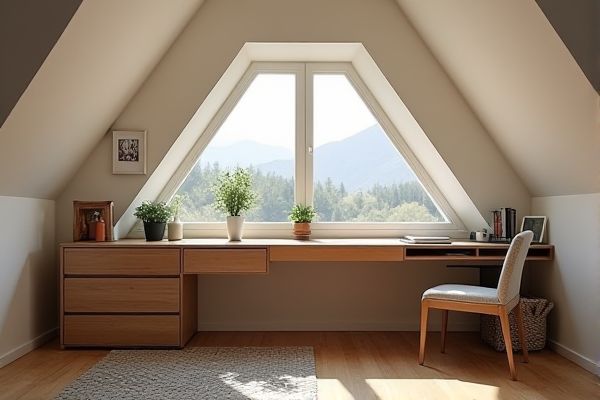
Choosing between an attic standing desk and a sitting desk depends on your ergonomic needs and available space, as standing desks promote movement and reduce sedentary time while sitting desks offer comfort for extended periods. Explore the key differences, benefits, and tips to help you determine which desk setup will enhance Your productivity and wellbeing in the rest of the article.
Table of Comparison
| Feature | Attic Standing Desk | Sitting Desk |
|---|---|---|
| Height | Adjustable to standing height (typically 40-45 inches) | Standard sitting height (typically 28-30 inches) |
| Ergonomics | Encourages active posture, reduces back strain | Supports seated posture, may cause sedentary risks |
| Space Efficiency | Ideal for low attic ceilings with limited vertical space | Requires more vertical clearance |
| Health Benefits | Promotes movement and reduces prolonged sitting issues | Risk of poor posture and related health problems |
| Usage | Best for tasks requiring frequent standing or shifting positions | Best for focused seated work |
| Setup Cost | Usually higher due to adjustable or custom design | Generally lower, standard desk costs apply |
Introduction to Attic Home Office Setups
Attic home office setups benefit from the flexibility of standing desks, which maximize limited vertical space while promoting better posture and reducing sedentary time. Unlike traditional sitting desks, attic standing desks can be adjusted to fit sloped ceilings and irregular layouts, enhancing ergonomic comfort and productivity. Choosing a standing desk in an attic environment supports health and efficient use of often cramped areas, essential for remote work or creative tasks.
Understanding Standing Desks: Benefits and Drawbacks
Standing desks promote better posture and increased energy levels by encouraging you to avoid prolonged sitting, which can reduce risks of cardiovascular issues and improve productivity. However, they may cause fatigue or discomfort in your legs and lower back if not used with proper ergonomics or gradual adjustments. Balancing standing and sitting throughout the day with an adjustable attic desk can optimize comfort and health benefits for your workspace.
Sitting Desks in the Attic: Comfort and Efficiency
Sitting desks in the attic offer a cozy workspace that maximizes limited space while providing ergonomic comfort for extended periods. Proper insulation and natural light in attic settings enhance your productivity by creating a comfortable, efficient environment. Optimal desk placement and ergonomic chairs support healthy posture and workflow, making attic sitting desks a practical choice for home offices.
Space Optimization: Standing vs Sitting Desks in Attic Rooms
Standing desks in attic rooms optimize space by taking advantage of vertical room height and allowing flexible positioning under sloped ceilings, enhancing ergonomic comfort without crowding limited floor area. Sitting desks often require more horizontal floor space and may restrict movement in cramped attic layouts, making them less practical for maximizing confined attic dimensions. Choosing a standing desk improves space utilization and functionality in attic rooms by adapting to their unique architectural constraints.
Ergonomic Considerations for Attic Workstations
Attic standing desks offer improved posture and reduced risk of musculoskeletal disorders compared to traditional sitting desks by encouraging movement and preventing prolonged sitting. Proper ergonomic setup in an attic workspace includes adjustable desk height to match individual stature, sufficient head clearance to avoid strain from sloped ceilings, and adequate lighting to minimize eye fatigue. Ensuring these ergonomic elements enhances comfort and productivity while mitigating common attic workstation challenges like limited space and awkward angles.
Health Implications: Standing Desk vs Sitting Desk
Standing desks reduce risks associated with prolonged sitting, such as cardiovascular disease, obesity, and lower back pain, by promoting increased movement and improved posture. Sitting desks, while comfortable, contribute to sedentary behavior linked to metabolic syndrome and decreased calorie expenditure. Incorporating adjustable desks that alternate between sitting and standing positions offers optimal ergonomic and health benefits.
Productivity Differences in Attic Office Arrangements
Attic standing desks can significantly enhance productivity by promoting better posture and increased movement, which reduces fatigue and improves focus during long work hours. In contrast, sitting desks in attic offices may lead to discomfort and decreased energy levels, potentially hindered by lower ergonomic flexibility in confined attic spaces. Your choice between standing and sitting desks should consider the unique spatial constraints and natural light availability to maximize productivity in an attic office arrangement.
Furniture Selection and Placement for Attic Offices
Choosing the right furniture for attic offices requires careful consideration of space constraints and ergonomic needs, making standing desks a versatile option due to their adjustable height and compact design. Sitting desks often demand more floor area, which may be limited in attics with sloped ceilings, while standing desks can optimize airflow and movement, enhancing productivity in smaller or uniquely shaped spaces. Your attic office benefits from furniture that adapts to the structural angles and maximizes usable square footage, promoting comfort and efficient workspace organization.
Cost Comparison: Standing Desk vs Sitting Desk Solutions
Standing desks typically have higher upfront costs than sitting desks due to adjustable mechanisms and ergonomic features, with prices ranging from $300 to $800 or more. Sitting desks usually cost between $100 and $400, offering a more budget-friendly option but lacking the health benefits associated with standing desks. Investing in a standing desk can improve your posture and reduce sedentary risks, potentially lowering long-term health expenses despite the initial price difference.
Which Desk Is Better for Your Attic Workspace?
An attic standing desk optimizes limited vertical space, promotes better posture, and reduces sedentary time, making it ideal for small, angled ceilings. A sitting desk offers traditional comfort and extensive surface area but may feel cramped under sloped attic roofs and increase prolonged sitting risks. Choosing the best desk depends on ceiling height, ergonomic preference, and the balance between movement and comfort in your attic workspace.
 homyna.com
homyna.com